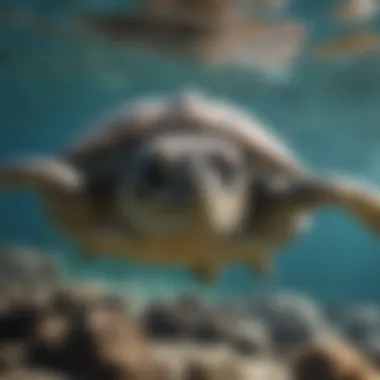Exploring the Sleep Patterns of Sea Turtles


Nature Topic Overview
Sleep, that simple act we often take for granted, takes on a whole new meaning in the underwater world of sea turtles. These magnificent creatures have been swimming along our oceans for millions of years, but their sleeping habits remain a mystery to many. Unlike humans, who snooze in a cozy bed, sea turtles have adapted their resting behaviors to survive in the vast and sometimes perilous marine environment.
The way these ancient reptiles sleep is not just fascinating; it's vital for their well-being. Through years of evolution, sea turtles have developed unique methods to rest while remaining vigilant against predators and environmental changes. In this article, we will examine their sleeping patterns, how they adapt to their surroundings, and the importance of sleep in their survival.
Fun Facts and Trivia
- Sea turtles can hold their breath for several hours while sleeping!
- Did you know that a turtle's heart rate can slow down significantly when it rests, allowing it to conserve energy?
- Some species, like the Leatherback Turtle, can dive deep into the ocean and might sleep while floating just below the surface.
- Sea turtles have a special nictitating membrane that covers their eyes. This helps protect them while they sleep.
"Sea turtles sleep during the day and night depending on their age, species, and habitat. Some even take short naps!"
Wildlife Explorations
Different species of sea turtles exhibit diverse sleeping habits. For instance, the green turtle often rests in seagrass beds, where it can find food and safety. On the other hand, loggerhead turtles might choose rocky crevices at the sea floor to snooze. Here's a peek into a few species:
- Green Sea Turtle: Prefers shallow waters and seagrass beds.
- Loggerhead Sea Turtle: Known for its large head and often found in temperate waters.
- Hawksbill Sea Turtle: Prefers coral reefs and is crucial for keeping them healthy.
Children can learn through interactive quizzes about these different species. For example, they could match pictures of sea turtles with their sleeping locations or habitats.
Environmental Awareness
The conservation of sea turtles is paramount, as these majestic animals face threats from habitat loss, pollution, and climate change. It’s essential we take steps to protect them. Here are some easy ways for kids to get involved:
- Beach Clean-ups: Removing litter from beaches helps maintain their nesting areas.
- Educational Projects: Create posters or presentations about sea turtles and their habitats to share with friends and family.
- Support Conservation Efforts: Many organizations focus on the protection of sea turtles; consider fundraising or volunteering.
DIY Nature Activities
Engaging children through hands-on activities can deepen their understanding of marine life. Here are some fun tasks they can try:
- Create a Turtle Habitat: Use a shoebox to craft a sea turtle’s environment, decorating it with clay or paper to represent the ocean floor and plants.
- Sleepy Turtle Craft: Draw or make a sea turtle using paper plates and show where it likes to rest.
- Outdoor Exploration: Plan a trip to a local beach or aquarium. Observing turtles in their habitats can inspire appreciation and a desire to protect them.
Preamble to Sea Turtles
Sea turtles are fascinating creatures that have roamed the oceans for over 100 million years. This article seeks to explore their sleep habits, which are not only crucial for their survival but also key to understanding their overall behavior and ecology. By examining various aspects of sea turtles' lives, such as their species, habitats, and distributions, we can appreciate their unique adaptations to life in the water. Understanding how these turtles sleep sheds light on their health and conservation needs, highlighting the importance of protecting these ancient reptiles.
Overview of Species
Sea turtles belong to the family Cheloniidae and Dermochelyidae, with seven distinct species swimming through our planets oceans. Each species showcases unique characteristics:
- Leatherback Turtles: The largest of the sea turtles, capable of diving deeply and regulating their body temperature.
- Green Turtles: Known for their herbivorous diet, primarily eating seagrasses and algae.
- Loggerhead Turtles: Recognizable by their large heads, they primarily eat hard-shelled prey like conchs and sea urchins.
- Hawksbill Turtles: Distinctive for their pointed beaks which enable them to feed on sponges found in coral reefs.
- Kemp's Ridley Turtles: The smallest species, often found nesting in groups on specific beaches.
- Olive Ridley Turtles: Similar to Kemp's, but larger, and known for mass nesting events.
- Flatback Turtles: Found only in the coastal waters of Australia, characterized by a flatter shell shape.
Each of these species plays a distinct role in their respective ecosystems, yet all share the common need for adequate rest. Their sleeping patterns can differ significantly, impacted by their species-specific characteristics.
Habitat and Distribution
Sea turtles inhabit a variety of marine environments, from warm tropical waters to the colder regions of the sea. They often utilize coastal areas for nesting and feeding, and some migrate thousands of miles between feeding grounds and nesting sites. Notable habitats include:
- Coral Reefs: These vibrant ecosystems provide an essential food source for many species.
- Seagrass Beds: Homes to green turtles, which rely on these underwater meadows for sustenance.
- Open Ocean: Some species, like the leatherback, are more pelagic, spending substantial time in the open water.
- Nest Beaches: Certain locations along coastlines serve as critical nesting sites, where females return annually to lay their eggs.
The distribution of sea turtles varies according to their species, with some found primarily in specific regions, while others are more widely distributed across global seas. Understanding the habitats that sea turtles occupy enhances our knowledge of their behaviors, particularly their sleep patterns, as these environments influence their resting strategies.
"In every drop of water, there is a story of life. Sea turtles symbolize the connections between creatures, habitats, and ecosystems."
Understanding where these turtles live helps us appreciate the diverse factors influencing their sleep. This is essential for ensuring their survival, especially in light of human threats such as habitat destruction and pollution.
The Concept of Sleep


Sleep plays a vital role not just in humans but across the animal kingdom, influencing physical health, behavior, and overall well-being. Understanding sleep patterns in sea turtles is particularly significant because it helps to illuminate how these reptiles manage their energy and resources in a challenging marine environment. More than a mere pause in activity, sleep is an essential function that supports vital processes such as growth, healing, and cognitive function.
Defining Sleep in Animals
Defining sleep in animals can be a bit tricky. Unlike humans, who might cozy up in a warm bed, animals have their own ways of catching some z's. Sleep for animals generally involves a state of reduced sensitivity to external stimuli, decreased muscle activity, and a noticeable shift in brain activity. For sea turtles, sleep takes on different dimensions depending on their needs and the environment around them.
When considering sleep in sea turtles, it’s essential to note that they don’t fully empty their minds. Much like a computer that's on sleep mode, a part of their brain stays alert, allowing them to be aware of potential predators and environmental changes. This type of sleep is often referred to as unihemispheric slow-wave sleep. It’s like keeping one eye open at a party!
Comparative Sleep Patterns
Comparative sleep patterns among animals reveal interesting similarities and differences. In fact, sea turtles exhibit unique sleep behavior in relation to other species.
- Mammals vs. Reptiles: Mammals tend to have structured sleep cycles with the REM (Rapid Eye Movement) phase playing a critical role in dreaming and memory consolidation. Sea turtles, being reptiles, show less differentiation and generally spend most of their time in a less intense sleep state.
- Aquatic vs. Terrestrial Animals: Many aquatic animals develop adaptations for sleeping in water. For example, dolphins are known for surfacing for air while sleeping, and sea turtles similarly have to find a balance between rest and the need to breathe. They might float just beneath the surface, allowing them to gulp air while still dozing.
- Examples from the Animal Kingdon: Some land-based animals sleep for extended periods, while sea turtles have shorter bouts of sleep, mainly due to their need to be vigilant against predators and environmental stresses. Scientists believe that loggerhead turtles, for instance, may sleep several hours daily when conditions are favorable, alternating periods of active swimming with rest.
In summary, the exploration of sleep behaviors in sea turtles reveals a complex interplay of ecological needs and biological functions. As we delve deeper into their specific sleeping habits, we gain a clearer picture of how these creatures manage survival in a watery world.
Do Sea Turtles Sleep?
Understanding whether sea turtles sleep is crucial to grasp how these ancient reptiles manage their energy and well-being in the vast oceans they call home. Given their unique biology and habitat, sleep has far-reaching implications for their survival. In essence, sleep plays a vital role in maintaining health and functionality for these remarkable creatures. As natural wanderers of the seas, knowing their sleep patterns helps us appreciate how they navigate challenges, from predators to environmental shifts.
Evidence of Sleep in Sea Turtles
Sea turtles exhibit signs of sleep similar to land animals, though it may look a bit different. Several studies have shown that these reptiles do indeed enter states of reduced responsiveness and lower activity levels, key indicators of sleep. Researchers have noted that sea turtles often spend long periods resting just below the water surface, allowing them to breathe while they are preparing for downtime.
The evidence supporting their sleep is compelling:
- Behavioral Research: Observers have recorded instances where turtles remain motionless for extended periods, often losing balance or drifting with ocean currents. This behavior suggests that they enter a state of rest.
- Physiological Studies: Tests on heart rate variability during resting periods show distinct patterns indicative of sleep phases, which aligns with resting behaviors observed.
- Video Documentation: Our understanding has been enhanced by underwater cameras capturing turtles in a state reminiscent of sleep, eyes partially closed, and minimal movement.
These observations solidify the view that sea turtles do engage in sleep, although it is designed around their aquatic life.
Behavioral Observations
Behavioral studies have revealed fascinating insights into how sea turtles sleep. Contrary to the common perception of sleeping creatures, these reptiles manage to doze off while remaining alert to their surroundings. In contrast to how we think of rest, their sleep can be quite functional.
Some notable observations include:
- Rising to the Surface: Sea turtles often surface to breathe while sleeping, providing a method of staying alive without fully waking up. They’ve adapted their sleep patterns to fit their habitat, ensuring a balance between rest and safety.
- Social Structures: Sometimes, sea turtles monitor each other while resting in groups. This social behavior underscores a community-based approach to ensuring safety during vulnerable moments.
- Napping Positions: The positioning of a turtle can indicate its state of rest. When they tuck their limbs close to their bodies, they might be taking a short break, albeit in a semi-alert state.
These behaviors manifest a complex interplay between need for rest and survival instincts. It paints a vivid picture of how sea turtles navigate the delicate balance of sleeping while being ever-watchful in the turbulent and dynamic marine environment.
"Understanding the subtle nuances of sea turtle sleep habits opens doors to better conservation strategies that respect their unique lifestyles and helps protect these ancient mariners."
In summary, exploring the question of whether sea turtles sleep reveals much more about their fascinating lives, providing insights into their biological rhythms and adaptations. Understanding these patterns can shine a light on the importance of protecting their habitats and ensuring their survival through conservation efforts.
Sleep Habits of Sea Turtles
When it comes to sea turtles, understanding their sleep habits holds significant importance. This isn’t just about how long they slumber or where they find their cozy spots in the vast ocean. It also opens a window into their world, highlighting their unique adaptations for survival and how they cope with the challenges of marine life. Knowing where and how sea turtles rest can shed light on their overall health and behavior, which is crucial for conservation efforts.
Resting Locations
Sea turtles have some interesting choices for their resting locations. They don’t just drift off anywhere; these ancient creatures typically seek out safe havens in the ocean. Common spots include coral reefs, mangrove areas, and even sandy bottoms. These areas provide not only shelter but also an environment where they can relax without being too exposed to predators.
- Coral Reefs: These vibrant ecosystems are not just colorful; they provide great hiding spots during a turtle's nap. The corals and rocks give them cover, helping them avoid danger.
- Mangroves: Turtles often find refuge in the roots of mangroves. This habitat offers a calm water environment, almost like a safe harbor where turtles can catch some shut-eye.
- Sandy Bottoms: Some species prefer lounging on the ocean floor. Here, they can bury themselves slightly in the sand, which also helps them stay hidden from potential threats.
These choices show a level of thoughtfulness in their behavior. By finding the right location, they can conserve energy and keep themselves safe.
Duration and Frequency of Sleep


Now, let’s explore how long sea turtles actually sleep and how often they do it. Unlike people who might sleep in longer stretches at night, sea turtles often take multiple short naps throughout the day and night. This pattern relates to their need for survival.
- Duration of Sleep: A sea turtle can sleep anywhere from 4 to 10 hours a day, depending on the species and environmental conditions. It sounds short, but this sleep is intermittent, which means it can happen at various times.
- Frequency of Sleep: They are known to nap multiple times a day. Some studies even show that they might sleep for about 30 to 40 minutes at a time while coming up to the surface to breathe. This is necessary since they cannot remain underwater forever; they have to stay mindful of their surroundings.
"Sleeping at intervals helps them stay alert to predators and environmental changes."
While resting, their heart rate slows down, and they appear less active. So, next time you come across a sea turtle resting, remember they are taking quick, necessary breaks to maintain their health and safety.
In short, the sleep habits of sea turtles reveal a lot about their lifestyle and adaptations. From selecting the right spots for rest to balancing sleep and awareness, they navigate their aquatic world in ways that are both fascinating and vital for their survival.
Adaptations for Sleeping in Water
When we think about sea turtles, it's easy to get lost in the idea of them gliding through the ocean like graceful shadows. But did you know that their ability to sleep in such a watery world is nothing short of incredible? Understanding how sea turtles have adapted to sleep while floating in vast oceans gives us a glimpse into their survival strategies.
While sleeping, these ancient reptiles face a range of challenges, such as maintaining buoyancy, avoiding predators, and ensuring that their bodies can still function properly. Their adaptations are examples of evolution at play, blending biology with the demands of their environment.
Physiological Adaptations
Sea turtles have developed unique physiological features that allow them to rest without sinking or becoming vulnerable. One major adaptation is their buoyancy control. Sea turtles can adjust the amount of air in their lungs to float effortlessly near the surface while sleeping. Just like a balloon that floats or sinks based on how much air is inside, the turtles manage their buoyancy based on their lung capacity. This is crucial for avoiding the risk of drowning.
Moreover, their bodies are shaped in a way that minimizes drag, allowing them to conserve energy while they rest. The streamlined design of their shells and limbs helps them move through the water with little resistance, ensuring they can quickly swim away if needed.
Another key aspect is their use of slow-wave sleep. This lighter form of sleep means they can remain semi-alert to their surroundings. While snoozing, sea turtles are still able to detect nearby threats, thus maintaining a level of safety. These adaptations are vital for their survival as they rest in the water.
Behavioral Adaptations
Now, let's dive into how sea turtles behave while sleeping in the water. The way they choose their resting spots is important; most of them select areas with calm waters and plenty of vegetation. These locations not only provide camouflage from predators but also shelter against strong currents. It’s like picking the coziest corner of a room—the better the spot, the more relaxed they can be!
Some sea turtles have been observed sleeping while swimming slowly near the surface, a behavior that seems a bit wild. Yet, it serves a purpose: by moving gently, they can continue to take in oxygen while they rest. It's almost as if they’ve mastered the art of multitasking. Not only are they catching some Zs, but they’re also keeping an eye on the environment around them—a dual approach to relaxation and vigilance.
Additionally, social behavior can play a role in their sleeping habits. When they rest in groups, they can benefit from being surrounded by others, enhancing safety in numbers. This collective sleeping is not just about comfort; it’s a strategic move that strengthens their defense against potential threats.
The Role of Sleep in Sea Turtle Health
Understanding the role of sleep is crucial in grasping how sea turtles function, especially in their natural habitats. Sleep is often overlooked when considering the overall health of animals, yet for sea turtles, it plays a vital role in multiple aspects of their well-being. These ancient mariners, who have swum through oceans for millions of years, rely on sleep not just for rest, but as a cornerstone for their survival processes.
The significance of sleep in sea turtle health can be illustrated by considering a few key elements:
- Recharge for Activity: Sleep enables sea turtles to recharge after long activities like foraging or traversing vast distances in search of nesting sites.
- Immune Defense: A well-rested sea turtle is less susceptible to infections. Sleep enhances their immune response, making the difference between thriving and merely surviving.
- Metabolic Balance: Proper sleep patterns regulate metabolism, helping sea turtles to efficiently utilize energy derived from their diet. In short, sleep is integral to maintaining their energy balance.
- Cognitive Function: Although their brains are not as large or complex as those of mammals, sea turtles also benefit from sleep in terms of processing information and learning.
Sleep and Immune Function
Sleep has a direct impact on the immune system of sea turtles. When they rest, their bodies have time to regroup and strengthen defenses against infections. Just like how people tend to catch a cold when low on sleep, sea turtles are vulnerable when they don't get enough rest. Feeding and swimming can expose them to pathogens in the ocean. If a turtle’s sleep is disrupted for extended periods, it might struggle to ward off these diseases.
Research shows that during deep sleep, the production of immune cells increases, boosting the turtle's ability to fight off infections. In other words, without adequate sleep, their immune system becomes akin to a castle with weakened walls—easily penetrated by invaders.
Sleep and Metabolism
A critical aspect of sea turtle health is their metabolism, which is closely linked to their sleeping habits. Just as sleep helps humans regulate appetite through hormone control, sleep assists sea turtles in maintaining their metabolic rate. Sea turtles utilize a unique metabolic strategy called bradycardia, where their heart rate slows while they sleep, enabling them to conserve energy.
Key points to remember about metabolism in relation to sleep include:
- Energy Conservation: Reduced metabolic activity during sleep helps to save energy, which is crucial as sea turtles swim across vast distances in search of food.
- Digestive Health: Sleep helps optimize digestion. When a turtle has fed, sleep can assist in processing the food effectively, turning it into the necessary nutrients they need. A sleep-deprived turtle might not digest food as well, leading to nutrient deficiencies.
- Growth and Development: Young turtles, in particular, benefit from sleep, as it is when their bodies perform much of their growth and repair. Without proper rest, young turtles may struggle to grow at an optimal rate, affecting their chances of survival.
Environmental Influences on Sleep
Understanding how environmental factors impact the sleep patterns of sea turtles sheds light on their unique adaptations and survival strategies. Sea turtles, with their long lifespan and migratory behavior, are shaped by various elements in their surroundings. These influences range from light conditions to the temperature of the ocean, each playing a vital role in their overall health and well-being.


Impact of Light and Darkness
Light is a crucial element affecting sea turtles, especially in regards to their sleep cycles. Just like we humans respond to day and night cycles, these marine reptiles also use the natural rhythm of light to navigate their daily activities and rest periods.
Sea turtles experience sleep in phases influenced by natural light. During the day, they tend to be more active, basking in sunlight. At night, when darkness envelops the ocean, they are likely to retreat into calming depths to catch some restorative sleep. This light-dark cycle not only affects sleep patterns but also plays a significant role in functions such as hunting and avoiding predators. In fact, many studies have shown that full moon nights, where the ocean is brightly illuminated, can disrupt their resting habits, prompting them to remain more alert against the risks posed by predators.
"Sea turtles synchronize their activities with the changing patterns of light, demonstrating the intricate ways in which they adapt to their environment."
Key Considerations:
- Sea turtles often rely on moon cycles for navigation, which can impact their sleep.
- Light pollution from coastal development can disrupt their natural cycles, making them more susceptible to stress and predation.
Effects of Water Temperature and Currents
Water temperature and currents are another vital component of the sea turtle’s sleeping habits. Sea water ranges in temperature depending on location and seasonal changes. Sea turtles are ectothermic, meaning their body temperature largely reflects their surrounding environment. Thus, warmer waters can encourage more active behavior due to increased metabolism and a greater availability of food, while cooler waters may prompt a decreased activity level, leading to longer periods of rest.
Currents also play a big role. Strong ocean currents can make resting periods more challenging, particularly if they are located in open waters. Sea turtles have been observed to seek shelter in calmer bays and coastal areas where they can rest safely.
Important Details:
- Temperature Variance: Higher temperatures may boost metabolism, requiring sea turtles to rest more frequently.
- Current Impact: Favorable currents can help them drift effortlessly, reducing physical strain during sleep.
In summary, the environment in which sea turtles live intricately influences their sleep behavior. Factors such as light and water conditions are not mere background details; they are essential elements that shape the sleeping patterns, overall health, and survival of these remarkable creatures. By understanding these influences, we nurture a greater appreciation for the lives of sea turtles and the importance of their preservation.
The Impact of Human Activity
Human activity plays a significant role in shaping the environment that sea turtles inhabit. These incredible creatures face numerous challenges due to human actions, making it essential to understand how these activities affect their sleep patterns and overall well-being. The stakes are high—from pollution that degrades their habitat to the pressures of climate change that disrupt their natural behaviors. Addressing these issues is not only crucial for sea turtles but also for the health of our oceans and biodiversity.
Threats from Pollution and Habitat Loss
Pollution is like a shadow lurking in the waters where sea turtles swim. Plastic waste, for instance, has become a nightmare for marine life. Sea turtles often mistake plastic bags for jellyfish, one of their favorite meals. Consuming these materials can lead to serious health problems or even death. Moreover, pollution can contaminate the ecosystem, affecting food sources that turtles rely on for sustenance.
Additionally, habitat loss due to coastal development and industrialization poses significant threats. Beaches are not just beautiful landscapes; they are vital nesting grounds for turtles. Development activities disrupt nesting sites, making it hard for females to lay eggs safely. As a result, fewer hatchlings make it to adulthood, which reduces the overall population of these majestic creatures.
"Without clean oceans and safe nesting grounds, the chances for sea turtle survival dwindle."
Conservation Efforts and Their Importance
Conservation efforts are the lifeline for sea turtles. Various organizations around the globe have sprung into action to tackle the issues of pollution and habitat degradation. For instance, beach clean-ups remove harmful debris from nesting sites, ensuring mothers can lay their eggs without obstacles. It's not just about cleaning up; education plays a vital role too. Teaching communities about the importance of protecting these areas helps to create a culture that values marine life.
Legal protections also play a critical part. Many countries have laws that safeguard sea turtle habitats and restrict activities known to harm them. Establishing marine protected areas allows turtles to thrive, reducing human interference in crucial feeding or nesting regions.
Ultimately, every effort counts. Each small step we take towards conservation can lead to a brighter future for these remarkable creatures. By inspiring young minds and engaging the public, we can foster a greater understanding of the need to protect sea turtles and their habitats. Every turtle saved today could mean a thriving population tomorrow.
Concluding Thoughts
The Importance of Understanding Sea Turtle Sleep
By unraveling the complexities of how and when sea turtles sleep, we shed light on their lifestyles and how they interact with their surroundings. Some key takeaways include:
- Sleep Habits: Knowing that these turtles have varying sleep patterns helps conservationists understand their needs.
- Health Monitoring: Awareness of their sleep can serve as an indicator of their overall health. For instance, changes in sleeping behavior could signal distress or environmental threats.
- Adaptations: Recognizing the unique adaptations sea turtles have evolved for sleeping in water informs us about their evolutionary processes and ecological niches.
All these aspects amplify the significance of sleep in the context of the broader ecosystem and the survival of the species.
Encouraging Awareness and Conservation
With knowledge comes responsibility. When people learn about how sea turtles need to rest, it sparks a desire to protect them and their habitats. Here are ways we can promote this awareness:
- Education: Schools can introduce programs about marine life and sleep science, emphasizing the importance of these magnificent creatures.
- Community Involvement: Local clean-up efforts at beaches can greatly benefit nesting sites, encouraging families to participate and understand their impact on sea turtle conservation.
- Funding Research: Supporting scientific research on sea turtle sleep can lead to better conservation strategies and ensure these amazing creatures thrive into the future.
"Every action we take today can help secure a future for sea turtles tomorrow."
Through education and activism, we can contribute to safeguarding their natural environments and fostering a deeper appreciation for the role sea turtles play in our oceans. In summary, understanding their sleep is not just an academic interest; it is a call to action for all who wish to protect our blue planet.







